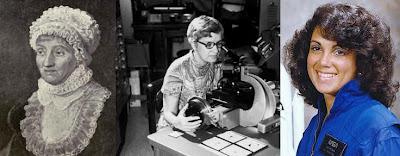 While most people don’t usuallyassociate Jewish women with space and astronomy, they have a surprisingly richhistory in the subject.
While most people don’t usuallyassociate Jewish women with space and astronomy, they have a surprisingly richhistory in the subject. Caroline Lucretia Herschel(1750-1848) was an astronomer whose father was of Jewish descent. Raised in Hanover, she moved to England when she was 22 because herbrother, the astronomer William Herschel, invited her to live with him. Shehappily took advantage of the opportunity and relocated to Bath. William was originally a musician andbegan dabbling in astronomy as a hobby. Caroline became involved in the studyof the stars when her brother did, teaching herself from his notes and books.
She quickly became an astronomerin her own right. Herschel greatly contributed to the astronomy field,discovering several comets in the 1780s and 90s. Most notably, she discoveredthe 35P/Herschel-Rigollet comet in 1788 and the Messier 110 Galaxy in 1783. Shealso compiled the Catalogue of Stars, an important book in astronomicalhistory. When she returned to Hanoverafter her brother’s death in 1822, she compiled a catalog of nebulae. As aresult, she won the Gold Medal of the Royal Astronomical Society, the highesthonor the association awards.
Herschel was certainly agroundbreaker. She actually received wages from the government for her work, afeat that was difficult for men to accomplish. Herschel was also one of thefirst two women to receive honorary membership to the Royal AstronomicalSociety. Her donations to science have been recognized: an asteroid discoveredin 1888 was named after her, as well as a crater on the Moon.
The next woman to receive theGold Medal was Vera Rubin in 1996. An American Orthodox Jew, she graduated fromVassar in 1948. When she applied to Princeton’sastronomy program, she was denied due to her gender. (Princeton didn’t acceptwomen into this program until 1975.) She attended Cornell for her MA instead,and received a PhD from Georgetown.She went on to discover an inconsistency between the predicted angular motionof galaxies and the observed motion by studying galactic rotation curves. Thisbecame known as the galaxy rotation problem. (I’m not a science person, so Idon’t really understand what this means. It sounds like it’s a big deal, so I’massuming it really is one.)
I think it’s really interestingthat the first two (out of three total) female winners of the Gold Medal wereJewish. It’s especially cool that Rubin identifies as Orthodox, since you oftenfind that scientists reject religion.
Another famous Jewish woman inspace is Judith Resnik, z”l. She was the second woman, second Jew, firstAmerican Jew, and first Jewish woman in space. When images of Resnik first cameback to Earth, people were surprised to see her hair floating all over theplace in weightlessness, since they were still used to the idea of astronautsas men with buzz cuts. Resnik’s career was cut tragically short when she diedduring the 1986 Challenger disaster.
While I have very little interestin math or science, it’s still heartwarming to see all of these amazing Jewishwomen who did, and to know that my peers have the chance to explore spacebecause of their actions.

